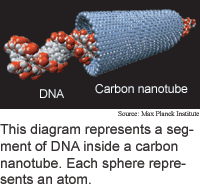
Study shows DNA will fill tubes
Researchers from the Max Planck Institute
in Germany have shown by computer simulation that it is possible to insert
DNA into a carbon nanotube.
Carbon nanotubes are rolled-up sheets of carbon atoms; they have
useful electronic properties and can be smaller than one nanometer in diameter,
which is the length of a row of 10 hydrogen atoms. Previous research has
shown that it is possible to use DNA, the molecule that holds and replicates
the code that makes up life's processes, for microelectronics.
Devices based on the DNA-nanotube combination could eventually be
used to make electronics, molecular sensors, devices that sequence DNA electronically,
and even gene delivery systems, according to the researchers.
The researchers' simulation showed that in a liquid environment,
a combination of the van der Waals force and hydrophobic interaction forces
would pull a strand of DNA into a nanotube. The van der Waals force is a
weak force of attraction between atoms and molecules.
It could be possible to use the method to make DNA-modulated electronics
in five to ten years, according to the researchers. The work appeared in
the April 9, 2003 issue of Nano letters.
Shock waves tune light
Artful displays track data
Plastic transistors go vertical
Artificial beings evolve realistically
News briefs:
Microfluidics go nonlinear
Browser boosts brain interface
Semiconductor emits telecom light
3D display widens view
Study shows DNA will fill tubes
DNA part makes transistor

Research Watch blog
View from the High Ground Q&A
How It Works
RSS Feeds:
News
Ad links:
Buy an ad link
Ad links: Clear History
Buy an ad link
|
TRN
Newswire and Headline Feeds for Web sites
|
© Copyright Technology Research News, LLC 2000-2010. All rights reserved.